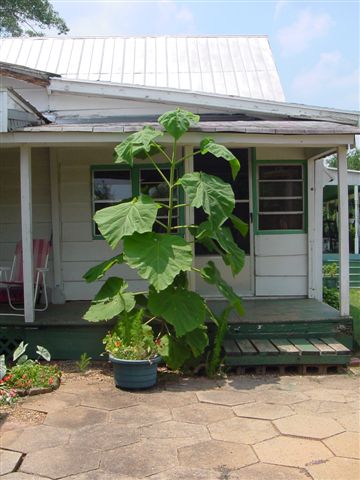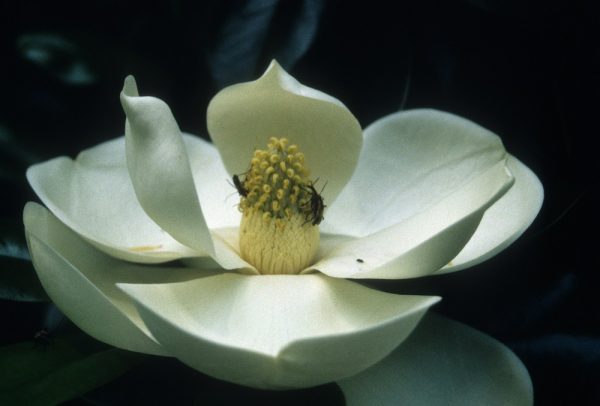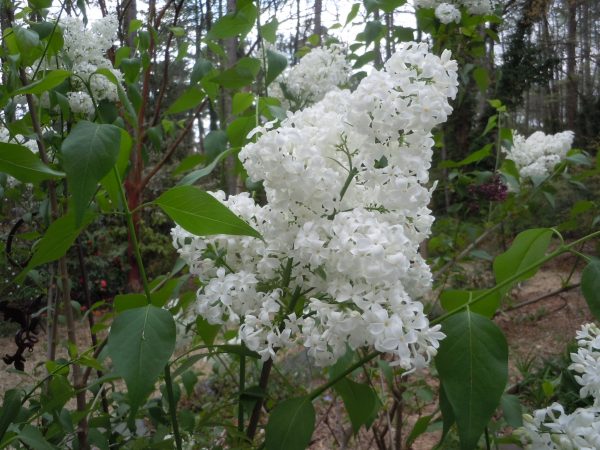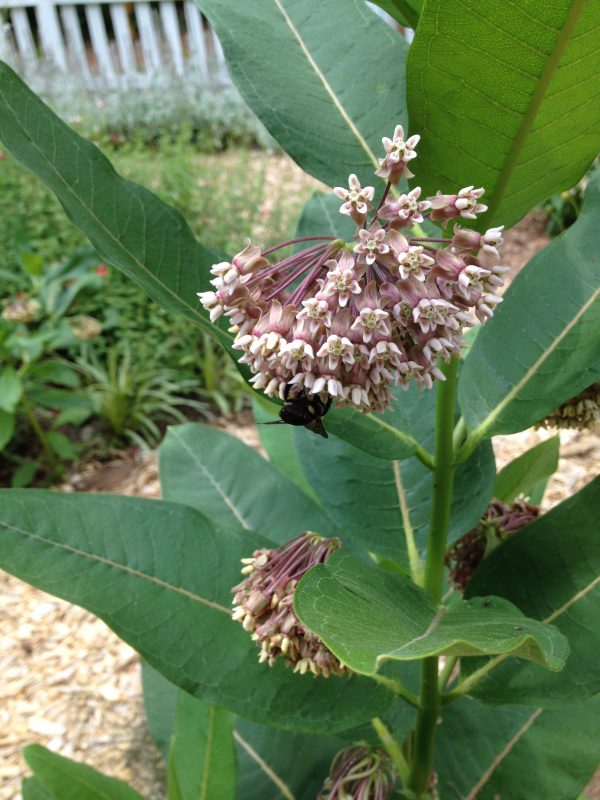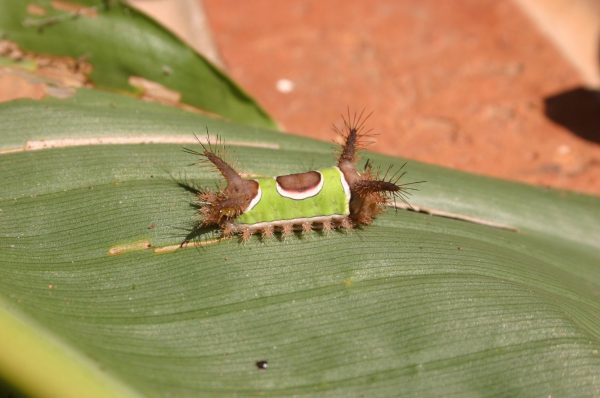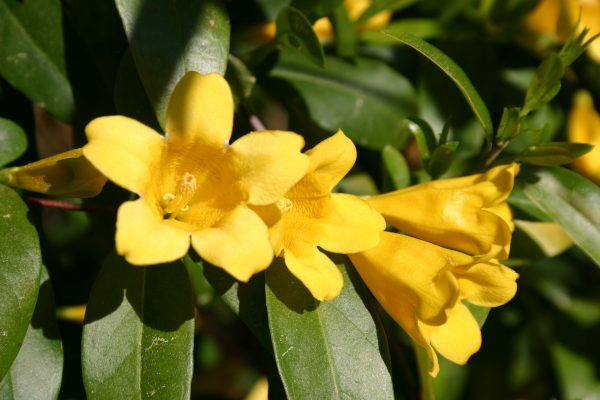Black Walnut
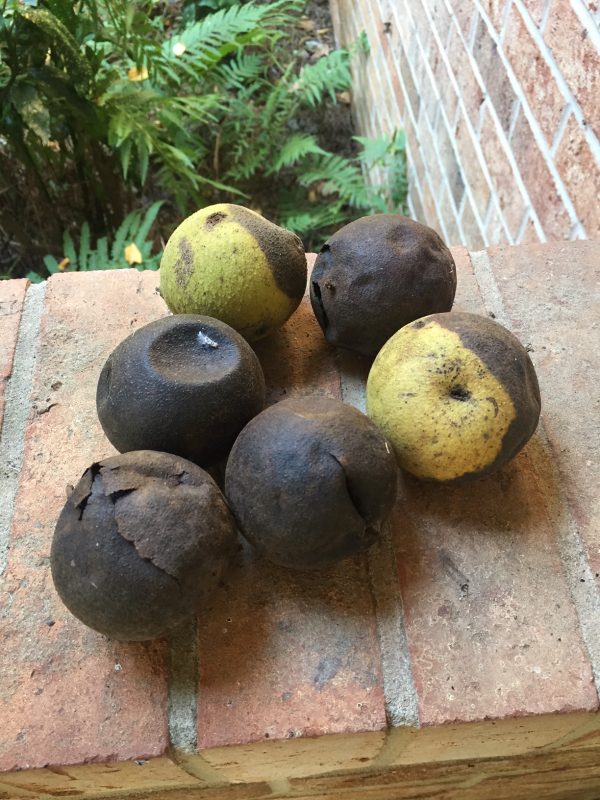
Juglans nigra
Black Walnut is native to North America and does well in the South in well-drained soil. Few gardeners plant them purposely but many may find one growing on property they purchase or inherit.
• More detailed information can be found in The Georgia Fruit & Vegetable Book by Walter Reeves and Felder Rushing
• See also Home Garden Black Walnut
(broken link)
Black Walnut leaves change to a golden yellow color in fall. The nut meat is almost impossible to remove whole from the shell but the effort is rewarded by a delicious addition to cookies and cakes.
WHEN TO PLANT
Black Walnut is difficult to transplant due it its long taproot. Trees less than three feet tall may be attempted but be sure to dig a deep root ball and a corresponding planting hole. Nuts can be planted in a small nursery bed in fall. Cover with 1-inch mesh chicken wire held down with bricks to thwart squirrels digging them up. Plant year-old seedlings in fall, to take advantage of root growth during the winter. Otherwise, transplant in spring as soon as the soil dries enough to be worked.
WHERE TO PLANT
Walnuts prefer deep, sandy, well-drained soil but can grow tolerably well in most soils of the South. They cannot tolerate constantly wet soil. They must have full sunshine in order to produce many nuts.
Trees grow fifty to seventy feet tall with an equal spread. Since Walnut roots exude a potent plant herbicide, do not plant near your garden or fruit trees. (SEE BELOW) If you must garden nearby, use raised beds exclusively.
HOW TO PLANT
Dig a hole deep enough so that the tree can be set at the same depth that it grew in the nursery bed. The taproot may be two feet long after only a year’s growth. Firm the soil occasionally with your shoe as you fill the hole to soil surface level. Pour ten gallons of water at the base of the tree to insure the soil around the roots gets thoroughly wet. Do not place fertilizer in the hole. Mulch a three foot diameter circle around trees with a two-inch layer of pine straw, chopped leaves or wood chips. This helps hold moisture and limits competition from grass and weeds.
CARE AND MAINTENANCE
If no soil test was done, spread one pound of 10-10-10 fertilizer distributed in a 25 sq. ft. area around the tree in March after a young tree is planted. For the first four years after planting, in late February, apply a pound of 10-10-10 fertilizer for each inch of trunk diameter (measured one foot above soil surface). Do not place fertilizer within 12 inches of the trunk; instead broadcast the fertilizer in a broad band around the drip line of the tree.
Fertilizing Bearing Trees: In the absence of a soil test, broadcast a pound of 10-10-10 for each inch of trunk diameter (measured 4 1/2 feet above soil level) in mid- to late February. Repeat in June and September.
During the growing season, apply 10 to 15 gallons of water to trees less than five years old at weekly intervals, either by rainfall or irrigation. Older trees can usually fend for themselves during drought. Young trees should be pruned to develop a central leader. Pruning mature trees is usually not needed, except to remove broken limbs.
HARVEST
Black Walnut trees begin producing nuts when they are about 10 years old but the best nut production begins when trees are 30 years old. Good nut crops occur in approximately two out of five years. The nut is contained in a thin, green, leathery skin (the husk). The husk-covered nuts begin falling in late September. Pick up nuts regularly to avoid insect damage to the kernels. Remove husks immediately after harvest. This can be done by hand if you are sure to wear rubber gloves and old clothes to avoid stains. If you have a quantity of nuts, another method is to fill a burlap sack one quarter full and run over it two or three times with an automobile. The tire will loosen the husks so they are easy to peel off. Years ago, when small Southern farms grew corn to feed their animals, a cast iron corn sheller was reputed to be the very best Black Walnut de-husker available.
After removing husks, rinse nuts in water. Discard nuts that float; nuts that sink have full kernels and are worth your time to crack. A small hammer and a brick are the only tools some people use although long-handled adjustable pump pliers are said to do a good job as well.
VARIETIES
Named walnut varieties are occasionally found in the trade but it is usually simpler to plant Walnuts using nuts you harvest from a tree that is known to yield good nuts. Following are varieties you might run across in catalogs:
Variety
Comment
Thomas Myers
very large, thin shell, 20 nuts per lb.
Stabler
large nut with a large single lobe, cracks easily,
Sauber#1
large nut, nut separates freely from husk, 23 nuts per lb.
Ridgeway
large nut, heavy producer
Daniel’s
thin shell, medium sized nuts, heavy producer, tree has very straight and up-right growth.
SIDEBAR
Black Walnut trees have a chemical known as juglone in their roots, husks, leaves and bark. Juglone inhibits the growth of many plants which may be growing in your garden or landscape. This inhibition of plant growth is called allelopathy. Small amounts of juglone are released by live roots; even decaying Walnut roots can inhibit nearby plants for years after a treet is removed. Leaves, bark, or wood chips of black Walnut should not be used to mulch landscape or garden plants.
PLANTS SENSITIVE TO JUGLONE
Cabbage, Eggplant, Pepper, Potato, Tomato, Apple, Blackberry, Blueberry, Azalea, White Birch, Crabapple, Hackberry; Amur Honeysuckle, Lilac, Saucer Magnolia, Silver Maple, Mountain Laurel, loblolly Pine, Scotch Pine, white Pine, Privet, Rhododendron, Autumn Crocus (Colchicum), Peony
PLANTS TOLERANT OF JUGLONE
Lima Bean, Snap Bean, beet, Corn, Onions, Cherry; black Raspberry, red Cedar, Crabapple, Elm, Forsythia, Hawthorn, Hemlock, Hickory, black Locust, most Maples, Oak, autumn Olive, Pachysandra, Pawpaw, Persimmon, Sycamore, most Viburnums, Virginia Creeper, Bluebells, Kentucky Bluegrass, Daffodil, Daylily, Ferns, Fescue, Iris, Jack-in-the-Pulpit, Liriope, Narcissus, Phlox, Poison Ivy, Shasta Daisy, Trillium



